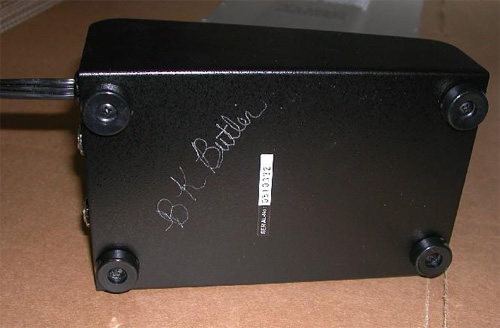

It also performs best with clean, high-wattage amplifiers with plenty of headroom (such as the Hiwatt amps that Mr. The Tube Driver is well-suited to tube swaps, sounding mellower and somewhat more compressed with a 12AU7, rather than the stock 12AX7. Eric Johnson, Joe Satriani, and Billy Gibbons have also done their part to canonize the Tube Driver's huge, dynamic overdrive and boost tones. The Tube Driver is legendary mostly because of its association with David Gilmour, who has used two of them on his board since the early 1990's and his work on Pink Floyd's Division Bell. The BK Butler Tube Driver has a sordid manufacturing history, having been made at various times and various places under both the Tube Works and Chandler names, before finally being produced in original form again by Butler himself, via his company, Butler Audio. But it's the best tube driven overdrive pedal I've ever used. But you can still get it on Amazon, probably eBay as well.


Again, this is modelled in Tonestack and gives access to pretty much all of what the two knob version allows and simplifies the use of the pedal.įiles for PCB design and manufacture can be found here.I'm not sure if anyone's making this anymore or not. A third option is also available with the Bass and Treble controls replaced by a single Tone control based on the Big Muff Pi. However, a more talented friend much preferred the original stack so PCB designs have been created for both. I experimented with a Vox topology with values chosen to allow the original repsonse to be approximated with the Bass set high and the Treble low and this is what I am currently using. The original tone stack has a very dark response and also doesn’t really exploit much of the sweep of the Bass control in particular (you can see the response of the Tube Driver tone stack in Tonestack). The design presented here offers a couple of minor variations from the original circuit – one being a simple emitter follower to buffer the output and the other being tweaks to the tone stack.

While the low plate voltage means that the valve does not dissipate significant power, the heater will still be running so this arrangement should improve ventilation while also making a statement on the pedal board! This means that the valve projects upwards out of the case (well away from the stomp switch) but not too far (other valve sockets would make this harder), and the exposed valve is then properly protected from physical damage by a robust circular valve guard. The Heart of Gold uses a single PCB with the valve mounted using a reversed socket (the FM7090 which is relatively to easy to find). While it is clearly debateable whether the presence of a valve in the circuit makes it any better than a hypothetical solid state offfering that provided identical sounds, it does, however, seem a shame that the Tube Driver’s main claim to fame is hidden away inside the pedal enclosure. While not an original design, the Heart of Gold is worthy of some discussion as a clone of the BK Butler Tube Driver – again, a genuinely different pedal with the added appeal of using a real tube. For hints and advice on building the pedals, please consult the main Pedals page. Files for PCB design and manufacture can be found here.


 0 kommentar(er)
0 kommentar(er)
